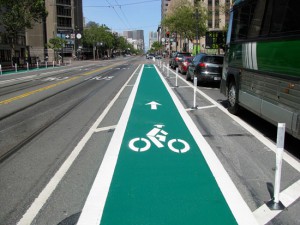Road Diets: A Legal Review
Over the past decade, a popular and controversial trend has gained momentum in progressive cities seeking to promote local bicycle and pedestrian transportation, even at the cost of slowing down the automobile. If you’ve seen new bicycle lanes popping up on your roads, then your neighborhood has already begun to embrace the road diet.
Road diet is a term coined to describe the elimination of vehicle lanes on a street in order to make room for bike lanes and/or increase sidewalk space. For example, a four-lane street with two lanes of traffic in each direction may be reduced to a three-lane road with marked bicycle lanes on each side and wider sidewalks.
Proponents of Road Diets
There are many road diet proponents who welcome the step away from automobile use in favor of bicycle and foot transportation. Advocates in favor say:
- Road diets can help build communities by getting people out of their cars and interacting with the neighborhood on-foot.
- They promote health and exercise.
- They protect the safety of bicyclists and pedestrians and reduce auto-accidents.
- They help the environment by reducing auto-use.
- Merchants may enjoy more business from increased pedestrian traffic.
- Property values may increase from neighborhood improvement.
Opponents of Road Diets
Still, many oppose this new trend in land development – especially traditional motorists concerned with getting from point A to point B. Often, these road diets occur in high traffic downtown areas and many fear that reduced lanes will result in road gridlock. Further, some studies have indicated that road diets may not in fact do much to help local economics as proponents suggest.
Legal Issues
When a city introduces a plan for a lane-reduction, several legal issues may arise.
1. City Plans
First, although cities have broad freedom to act for the general welfare of the community, one can look to the city plan to find authority that may promote or restrict a city’s road diet plan. For example, if a city states in their plan that one of their policies is to reduce traffic congestion, a road-diet could potentially conflict with that policy.
However, the city plan may also have policies promoting public safety, environment protection, and downtown growth, which could be advanced by a road diet.
2. Environmental Impacts
Some states require that cities complete environmental impact investigations prior to engaging in any projects that may affect the environment. For example, in California, there have been many instances of citizens using the California Environmental Quality Act (CEQA) to slow down city road diet plans and require the city first undergo required environmental analysis.
However, in California, a new 2013 law now exempts bike lanes from CEQA analysis, making it easier for cities to enact road diets and add bike lanes. Still, more extensive road diets that involve new sidewalk additions may still require traditional CEQA analysis.
3. Traffic and Safety Analysis & Public Hearings
Prior to enacting any road diet plans, cities should (and may be required to) conduct a public hearing and undergo investigation and analysis of the traffic and safety impacts associated with the proposed plan. Getting input from neighborhood citizens is important step in fact gathering and assessing community attitude toward the project.
Further, depending on the traffic situation, a road diet may not be appropriate in some areas. Some studies have found that streets that carry more than 20,000 cars a day are more likely to experience traffic gridlock issues from lane reductions. Thus, before undergoing any road diet plans, cities should investigate a number of issues including:
- Level of traffic
- Parking issues
- Affects on nearby streets
- Availability of alternate routes for cars
- Costs of the project and revenue resources
The Future of Road Diets
While the road diet trend likely isn’t going away anytime soon, public trains and digital commutes may help ease the burden off daily transportation in the future. Further, often road diets don’t lead to gridlock and still allow for normal traffic flow. In the instances when road diets fail, cities have been known to quickly re-paint the roads back to normal. In the mean time, if you’re not enjoying biking around your neighborhood already, now might be a good opportunity to embrace the road diet.



Comments